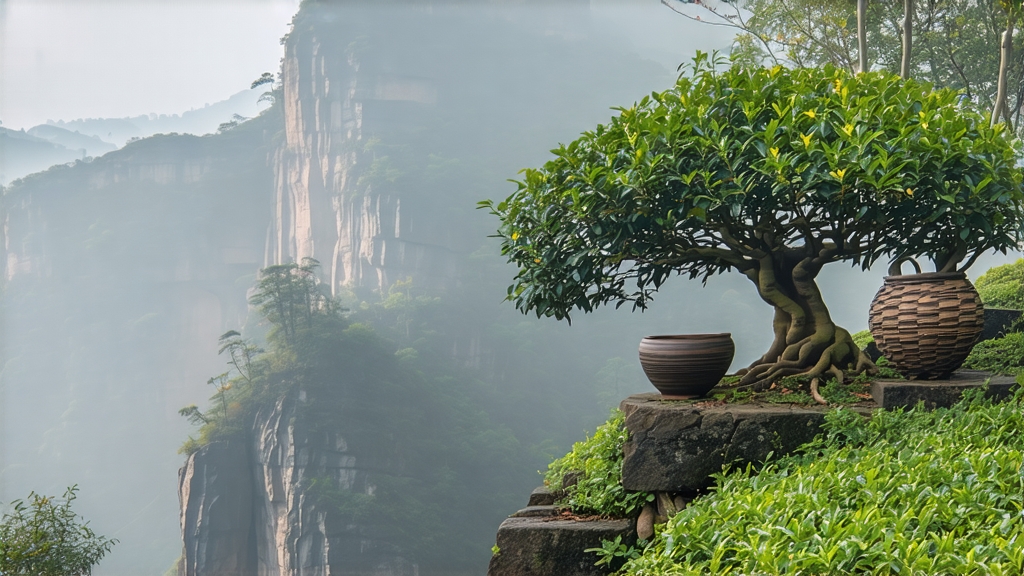
High in the UNESCO-listed Wuyi Mountains of northern Fujian, narrow bamboo ladders still lean against near-vertical cliffs where the tea cultivar Shui Xian—“Narcissus” in English—has rooted itself for more than three centuries. To international drinkers the name may sound poetic; to Chinese tea traders it signals one of the most dependable pathways into the enigmatic world of “rock oolong,” the yancha family whose leaves absorb the limestone minerals that drip from mist-saturated cliffs, then translate that geology into a lingering, almost saline sweetness known as yan yun, or “rock rhyme.” Shui Xian is therefore both a plant and a place, a flavor and a feeling, a daily beverage along the Min River and a ceremonial showpiece in Beijing teahouses. This article walks foreign enthusiasts through the cultivar’s history, the micro-terroirs that shape it, the labor-intensive charcoal roasting that guards it, and the quiet gongfu ritual that finally coaxes its orchid-and-stone song into the cup.
-
From Temple Garden to Cliff Garden: A 300-Year Journey
Local gazetteers credit a wandering monk from the nearby Tianxin Temple for first transplanting tea bushes onto the Wuyi cliffs during the late Ming dynasty (c. 1680 CE). Seeking a meditative supply of leaves, he supposedly chose a particularly fragrant bush growing beside a spring whose reflected moonlight resembled the mythical narcissus flower; hence the name. Whether apocryphal or not, the story underlines two constants in Shui Xian lore: spiritual solitude and water-sculpted stone. By the early Qing the cultivar had migrated down-slope into the village of Huiyuan, where farmers discovered that vegetative propagation—cloning by cutting—preserved the plant’s large, thick leaves and its talent for absorbing roasted flavors without losing floral brightness. When British tea thieves Robert Fortune and others smuggled black-tea techniques out of Wuyi in the 1850s, Shui Xian remained stubbornly oolong, its partial oxidation staking a middle path between the green teas of Japan and the emerging black teas of India. Today the cultivar is legally protected under China’s National Geographic Indication, and every authentic leaf must be picked within the 70-km² core scenic zone of the Wuyi range. -
The Three Faces of Shui Xian: Zhengyan, Banyan, Zhouyan
International catalogs often list “Wuyi Shui Xian” as if it were monolithic, yet locals divide the tea into three ascending quality tiers defined by distance from the nine sacred gorges that slice through the reserve.
- Zhengyan (“true cliff”) gardens sit inside the first ridge, where morning mist refracts light into a perpetual soft-box, soil pH hovers at 4.8, and temperature swings of 15 °C between day and night force the leaves to thicken their cell walls. The resulting tea exhibits the most pronounced yan yun, a tactile minerality that feels like licking a wet stone, followed by cooling camphor and ripe peach.
- Banyan (“half cliff”) fields lie just beyond the ridgeline, still within the heritage buffer zone but on gentler slopes where sediment has mixed with gravel. Cups are honeyed, slightly less tensile, yet capable of five or six gongfu infusions.
- Zhouyan (“riverine”) indicates terraced plots along the Chongyang and Jiuqu streams. These leaves grow faster, oxidize softer, and deliver a friendly orchid fragrance that makes them the workhorse of everyday Fujian cafés.
Knowing the tier is crucial when buying: zhengyan lots can fetch USD $400 per 100 g, whereas zhouyan may cost one-tenth that, but both are legitimately labeled “Wuyi Shui Xian.”
- Crafting the Rock Rhyme: Wilting, Shaking, Killing-Green, Roasting
The harvest window is merciless: only four days in late April when three leaves and a bud plump to the size of a sparrow’s tongue yet still snap cleanly. Leaves are spread on bamboo trays under the morning sun for 30 minutes, then moved indoors to wither on water-permeable racks. What follows is the most cinematic step—yaoqing, or “shaking.” Dozens of trays are stacked onto a circular bamboo drum that rocks like a slow-motion lottery tumbler